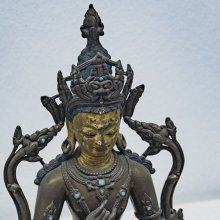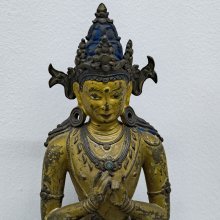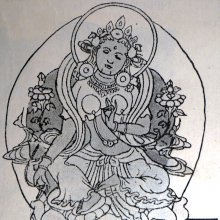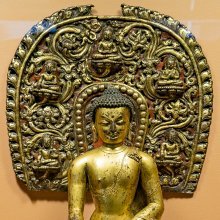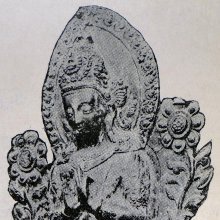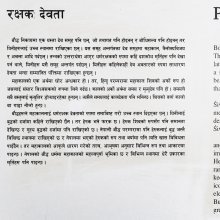Tathagata, Tathāgata, Tatha-gata: 18 definitions
Introduction:
Tathagata means something in Buddhism, Pali, Hinduism, Sanskrit, Hindi. If you want to know the exact meaning, history, etymology or English translation of this term then check out the descriptions on this page. Add your comment or reference to a book if you want to contribute to this summary article.
Alternative spellings of this word include Tathagat.
Images (photo gallery)
(+4 more images available)
In Buddhism
Theravada (major branch of Buddhism)
Source: Access to Insight: A Glossary of Pali and Buddhist TermsTathagata, literally, “one who has truly gone (tatha gata)” or "one who has become authentic (tatha agata), an epithet used in ancient India for a person who has attained the highest spiritual goal. In Buddhism, it usually denotes the Buddha, although occasionally it also denotes any of his arahant disciples.
Source: Pali Kanon: Pali Proper NamesTathagata:’An epithet of the Buddha, used by the Buddha in referring to himself. The Commentaries (DA.i.59-67; AA.i.58-63; MA.39-43; UdA.128ff., etc.) give eight (sometimes expanded to sixteen) explanations of the word, which shows that there was probably no fixed tradition on the point. The explanations indicate that the name can be used for any Arahant, and not necessarily only for a Buddha. The term was evidently pre-Buddhistic, though it has not yet been found in any pre-Buddhistic work.
Source: Dhamma Dana: Pali English GlossaryTathagata refers to the one who is enlightened, who has a perfect knowledge. The omniscient one. Buddha.
Source: Pali Kanon: Manual of Buddhist Terms and DoctrinesTathagata (“the perfect one”), lit. the one who has “thus gone”, or “thus come”, is an epithet of the Buddha used by him when speaking of himself.
To the often asked questions, whether the Tathāgata still exists after death, or not, it is said (e.g. S. XXII, 85, 86) that, in the highest sense (paramattha, q.v.) the Tathāgata cannot, even at lifetime, be discovered, how much less after death, and that neither the 5 groups of existence (khandha, q.v.) are to be regarded as the Tathāgata, nor can the Tathāgata be found outside these corporeal and mental phenomena. The meaning intended here is that there exist only these ever-changing corporeal and mental phenomena, arising and vanishing from moment to moment, but no separate entity, no personality.
When the commentaries in this connection explain Tathāgata by 'living being' (satta), they mean to say that here the questioners are using the merely conventional expression, Tathāgata, in the sense of a really existing entity. Cf. anattā, paramattha, puggala, jīva, satta. A commentarial treatise on "The Meaning of the Word 'Tathāgata' " is included in The All-Embracing Net of Views (Brahmajāla Sutta), tr. Bhikkhu Bodhi (BPS).
Theravāda is a major branch of Buddhism having the the Pali canon (tipitaka) as their canonical literature, which includes the vinaya-pitaka (monastic rules), the sutta-pitaka (Buddhist sermons) and the abhidhamma-pitaka (philosophy and psychology).
Mahayana (major branch of Buddhism)
Source: Wisdom Library: Maha Prajnaparamita SastraTathāgata (तथागत) is a synonym for the Buddha according to the 2nd century Mahāprajñāpāramitāśāstra (chapter IV).
Why is he called To t’o a k’ie t’o (Tathāgata)?:
1) He preaches the natures of the Dharmas (dharmalakṣaṇa) in the way (tathā) that he has understood (gata) them.
2) In the way that the previous Buddhas have gone by the path of safety (yogakṣema-mārga), thus (tathā) the actual Buddha is going (gata) and will not go on to new existences (punarbhāva).

Mahayana (महायान, mahāyāna) is a major branch of Buddhism focusing on the path of a Bodhisattva (spiritual aspirants/ enlightened beings). Extant literature is vast and primarely composed in the Sanskrit language. There are many sūtras of which some of the earliest are the various Prajñāpāramitā sūtras.
General definition (in Buddhism)
Source: Wisdom Library: BuddhismTathagata:—An honorific title of a Buddha.
Source: Soka Gakkai International: The Soka Gakkai Dictionary of BuddhismThus Come One [如来] (Skt, Pali tathagata; Jpn nyorai). One of the ten honorable titles of a Buddha, meaning one who has come from the realm of truth. This title indicates that a Buddha embodies the fundamental truth of all phenomena and has grasped the law of causality spanning past, present, and future. There are two opinions about the Sanskrit and Pali word tathagata. One view interprets it as a compound of tatha and agata, meaning "thus come one" and indicating one who has arrived from the realm of truth. This is the interpretation generally used in Chinese translations. The other interprets the word tathagata as the compound of tatha and gata, meaning "thus gone one" and indicating one who has gone to the world of enlightenment.
Languages of India and abroad
Pali-English dictionary
Source: BuddhaSasana: Concise Pali-English Dictionarytathāgata : (adj.) one who has gone so; the Enlighten One.
Source: Sutta: The Pali Text Society's Pali-English DictionaryTathāgata, (Derivation uncertain. Buddhaghosa (DA. I, 59—67) gives eight explanations showing that there was no fixed tradition on the point, and that he himself was in doubt). The context shows that the word is an epithet of an Arahant, and that non-Buddhists were supposed to know what it meant. The compilers of the Nikāyas must therefore have considered the expression as pre-Buddhistic; but it has not yet been found in any pre-Buddhistic work. Mrs. Rhys Davids (Dhs. tr. 1099, quoting Chalmers J. R. A. S. Jan. , 1898) suggests “he who has won through to the truth. ” Had the early Buddhists invented a word with this meaning it would probably have been tathaṃgata, but not necessarily, for we have upadhī-karoti as well as upadhiṃ karoti.—D. I, 12, 27, 46, 63; II, 68, 103, 108, 115, 140, 142; III, 14, 24 sq. , 32 sq. , 115, 217, 264 sq. , 273 sq.; S. I, 110 sq.; II, 222 sq.; III, 215; IV, 127, 380 sq.; A. I, 286; II, 17, 25, 120; III, 35, etc.; Sn. 236, 347, 467, 557, 1114; It. 121 sq.; KhA 196; Ps. I, 121 sq.; Dhs. 1099, 1117, 1234; Vbh. 325 sq. , 340, etc., etc.
--- OR ---
Tathāgata refers to: see sep.;
Note: tathāgata is a Pali compound consisting of the words tathā and gata.

Pali is the language of the Tipiṭaka, which is the sacred canon of Theravāda Buddhism and contains much of the Buddha’s speech. Closeley related to Sanskrit, both languages are used interchangeably between religions.
Sanskrit dictionary
Source: DDSA: The practical Sanskrit-English dictionaryTathāgata (तथागत).—a.
1) being in such a state or condition; तथागतायां परिहासपूर्वम् (tathāgatāyāṃ parihāsapūrvam) R.6.82.
2) of such a quality. (-taḥ) 1 Buddha; काले मितं वाक्यमुदर्कपश्यं तथागतस्येव जनः सुचेताः (kāle mitaṃ vākyamudarkapaśyaṃ tathāgatasyeva janaḥ sucetāḥ) Śi. 2.81.
2) a Jina; स्थिता तथागतमुखे श्रुतिं श्रुतिविदो यथा (sthitā tathāgatamukhe śrutiṃ śrutivido yathā) Śiva. B.5.44.
Tathāgata is a Sanskrit compound consisting of the terms tathā and gata (गत).
Source: Cologne Digital Sanskrit Dictionaries: Edgerton Buddhist Hybrid Sanskrit DictionaryTathāgata (तथागत).—(= Pali id.) = Buddha: Mahāvyutpatti 3 = Tibetan de bzhin gśegs pa, thus gone or come (could = gata or āgata; both theories are held; according to Jäschke (Tibetan-English Dictionary) and [Tibetan-English Dictionary], in Tibet today the commonly accepted interpretation is who goes, or has gone, in the same way, sc. as earlier Buddhas); seven listed Dharmasaṃgraha 6 (Vipaśyin, Śikhin, Viśvabhū, Krakucchanda, Kanakamuni, Kāśyapa, Śākyamuni); Vipaśyin is the first ‘of 7 Tathāgatas, of whom I (Śākya- muni) am the 7th’ Saddharmapuṇḍarīka 201.4; same list, with variant forms, (Ārya-)Mañjuśrīmūlakalpa 397.11; Divyāvadāna 333.3; and with other Buddhas, Lalitavistara 5.15; 20 listed Mahāvyutpatti 82—101, the above seven, with variants, in 87—94; passim in all texts; as adj., f. °gatī, only m.c. for tāthāgatī, of (a) Buddha(s), in list of bhūmi: dharma- meghā tathāgatī Laṅkāvatāra-sūtra 318.12 (verse; tāth° metrical(ly) impossible; sc. bhūmiḥ; see s.v. tāthāgata).
--- OR ---
Tāthāgata (ताथागत).—adj., f. °ī (from tathāgata plus -a), of or belonging, pertaining to the (or a) Buddha: °taḥ (vihāraḥ) Bodhisattvabhūmi 318.5; 367.13; °taṃ caturthaṃ dhyānam Laṅkāvatāra-sūtra 97.7; °tasya padasya Bodhisattvabhūmi 10.4; °tī (bhūmi) Laṅkāvatāra-sūtra 244.11; 318.12 (verse, here m.c. tathāgatī); bodhisattva- °tī bhūmiḥ Bodhisattvabhūmi 367.3; °tī (vidyā) (Ārya-)Mañjuśrīmūlakalpa 561.20; (pūjā) 600.25; (mudrā) 502.13; tāthāgatī-mantrāḥ (Ārya-)Mañjuśrīmūlakalpa 35.3; 392.17 (here °gatī seems to represent °gatī-mudrā, compare 392.13 tathāgata- pātra-mudrā-mantra anena saṃyuktaḥ); tatrottarāpathe sarvatra tāthāgatī-vidyā-rājñaḥ (compare line 4 vidyā-rājñāṃ; here tāthāgatī, which read in composition with vidyā, takes its gender from that word, see (Ārya-)Mañjuśrīmūlakalpa 561.20, above) siddhiṃ gacchanti saṃkṣepataḥ (Ārya-)Mañjuśrīmūlakalpa 325.5—6 (one might expect rājñī instead of rājan after vidyā, but this text tolerates such things).
Source: Cologne Digital Sanskrit Dictionaries: Shabda-Sagara Sanskrit-English DictionaryTathāgata (तथागत).—m.
(-taḥ) A Jina or Budd'ha. E. tathā thus, (what really is,) and gata known, obtained.
Source: Cologne Digital Sanskrit Dictionaries: Cappeller Sanskrit-English DictionaryTathāgata (तथागत).—[adjective] being in that condition, of such a quality or nature; [masculine] a Buddhist.
Source: Cologne Digital Sanskrit Dictionaries: Monier-Williams Sanskrit-English Dictionary1) Tathāgata (तथागत):—[=tathā-gata] [from ta-thā > tat] mfn. being in such a state or condition, of such a quality or nature, [Ṛgveda-prātiśākhya iii, 5; Mahābhārata; Mālavikāgnimitra v, 9/10]
2) [v.s. ...] ‘he who comes and goes in the same way [as the Buddhas who preceded him]’, Gautama Buddha, [Buddhist literature; Sarvadarśana-saṃgraha]
3) [v.s. ...] a Buddhist, [Saṃkṣepa-śaṃkara-vijaya i, 70; x]
Source: Cologne Digital Sanskrit Dictionaries: Yates Sanskrit-English DictionaryTathāgata (तथागत):—[tathā-gata] (taḥ) 1. m. A Jaina.
[Sanskrit to German]
Sanskrit, also spelled संस्कृतम् (saṃskṛtam), is an ancient language of India commonly seen as the grandmother of the Indo-European language family (even English!). Closely allied with Prakrit and Pali, Sanskrit is more exhaustive in both grammar and terms and has the most extensive collection of literature in the world, greatly surpassing its sister-languages Greek and Latin.
Hindi dictionary
Source: DDSA: A practical Hindi-English dictionaryTathāgata (तथागत) [Also spelled tathagat]:—(nm) a name of Lord Buddha.
...
Kannada-English dictionary
Source: Alar: Kannada-English corpusTathāgata (ತಥಾಗತ):—[adjective] being in a particular condition or state (referred to earlier).
--- OR ---
Tathāgata (ತಥಾಗತ):—
1) [noun] Gautama Buddha, founder of Buddhism.
2) [noun] a Buddha or Jaina mendicant.
3) [noun] any of the celebrated Jaina spiritual teachers.
Kannada is a Dravidian language (as opposed to the Indo-European language family) mainly spoken in the southwestern region of India.
See also (Relevant definitions)
Starts with (+24): Tathagata Sutta, Tathagatabala, Tathagatabalani, Tathagatabhadra, Tathagatabhashita, Tathagatabhisheka, Tathagatabimbaparivarta, Tathagatachintyaguhyanirdesha, Tathagatacintyaguhyanirdesha, Tathagatadasa, Tathagatadhishthana, Tathagatagarbha, Tathagatagarbhasutra, Tathagataguhyaka, Tathagataguhyasutra, Tathagatagunajnanacintyavishayavataranirdesha, Tathagatagupta, Tathagatahridaya, Tathagatajnana, Tathagatajnanamudrasamadhi.
Ends with: Pancatathagata, Saptatathagata, Sarvatathagata.
Full-text (+1386): Tathagataguhyaka, Tathagata Bala, Tathagatabhadra, Tathagatagunajnanacintyavishayavataranirdesha, Tathagatakoshaparipalita, Sarvatathagata, Samantaprajnaptinirghoshamegha, Samantaviryolkavabhasamegha, Sarvagatrajnanapratibhasacandra, Suparipurnajnanamukhavaktra, Suvishuddhajnanakusumavabhasa, Arcihsamudramukhavegapradipa, Dharmadhanashikharabhaskandha, Dharmameghavighushtakirtiraja, Ratnachattrabhyudgatavabhasa, Samantasuryavabhasaprabharaja, Sarvadharmasamadhiprabhaghosha, Sumerudhvajayatanashantanetrashri, Anavaranadharmagaganaprabha, Dharmanayagambhirashricandra.
Relevant text
Search found 119 books and stories containing Tathagata, Tathāgata, Tatha-gata, Tathā-gata, Tāthāgata; (plurals include: Tathagatas, Tathāgatas, gatas, Tāthāgatas). You can also click to the full overview containing English textual excerpts. Below are direct links for the most relevant articles:
Lankavatara Sutra (by Daisetz Teitaro Suzuki)
Maha Prajnaparamita Sastra (by Gelongma Karma Migme Chödrön)
Appendix 1 - Comparison of the Boddhisattva and the Buddha with the moon < [Chapter XLV - Application of Merit]
Part 3 - The Prajñāpāramitāstotra < [Chapter XXIX - The Virtue of Wisdom]
Bodhisattva quality 28: excelled in destroying various wrong views < [Chapter XIII - The Buddha-fields]
The Sutra of Queen Śrīmālā of the Lion’s Roar
Verses on the Perfection of Wisdom
The Gospel of Buddha (by Paul Carus)
The Great Chronicle of Buddhas (by Ven. Mingun Sayadaw)
Biography (19): Vakkali Mahāthera < [Chapter 43 - Forty-one Arahat-Mahatheras and their Respective Etadagga titles]
Part 25 - The Relinquishing of The Life-maintaining Mental Process < [Chapter 40 - The Buddha Declared the Seven Factors of Non-Decline for Rulers]
Part 42 - The Noble Qualities of Venerable Ānanda < [Chapter 40 - The Buddha Declared the Seven Factors of Non-Decline for Rulers]
Related products
